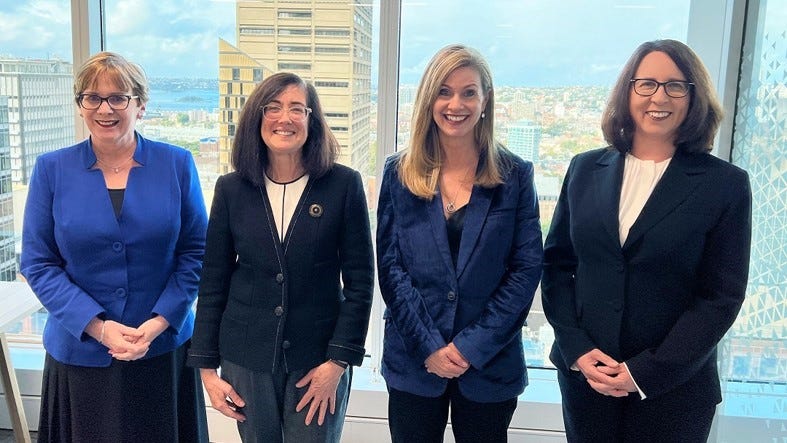
Now here's a funny thing. Take a look at this photo of the four people heading up Australia's Digital Platforms Regulators. The control of our county's high tech online business is firmly in the hands of women. Not a skerrick of gender diversity to be seen.
The cheerful long-haired blond is Julie Inman Grant, the powerful eSafety Commissioner whose 435 employees are beavering to keep our citizens safe online. The only problem is her cosy crew are devoting most of their efforts and $31m annual budget not to trying to protect us all from online abuse. Oh no, Ms Inman Grant has her own agenda.
Advertisement
"Technology is routinely being weaponised against women to demean, control and ultimately silence them," she pronounced at a National Summit on Women's Safety late last year. She justified her organisation's special focus on the fair sex by claiming that "Women are disproportionately targeted in every form of online abuse we deal with at eSafety."
Note that careful language – "every form of abuse we deal with at eSafety." Well, that's a bit of a give-away. Let's look at what exactly they choose not to deal with.
Last month the Australian Federal Police took the unusual step of releasing police intelligence to warn of "a spike in the number of Australian boys being preyed on by international sex offenders, who are grooming them into producing explicit images and then extorting them for money. They explained that reports have more than quadrupled between mid-2021 and this year. Similar warnings earlier in the month were issued by West Australian Consumer protection and WA police.
The problem is global and can lead to tragic consequences. The FBI recently issued similar warnings following the suicide of two 17-year-old boys, one in California, the other in Michigan. Watch this tragic CNN news video about Ryan Stuart, the San Jose boy, who received an online message in February from someone posing as a girl. The scammer sent Ryan a nude photo and asked him to share an explicit image of himself in return. As soon as Ryan sent the requested dick pic, the cybercriminal demanded $5,000, threatening to make the photo public and send it to Ryan's family and friends. The teenage boy told the scammer he could not pay the full amount, and the demand was eventually lowered to $150. But after Ryan paid that to the scammers using his college savings, they kept demanding more. Ryan wrote a desperate note saying he was absolutely terrified of the pictures being posted online, describing how embarrassed he was for himself and the family, and then took his own life – within hours of receiving the initial communication.
As Australian police made clear, that's a risk here too, with clever scammers preying on desperate boys who have nowhere to turn.
The inconvenient truth is buried by eSafety
Advertisement
Where's Ms Inman Grant and her eSafety team? Well, they've been busy, releasing their recent report on "how online abuse impacts women in their working lives" and other sundry items, but there's been not one word about boys in recent media releases. Inman Grant and her colleagues were nowhere to be seen when Kochie and mates on Channel 7 breakfast television chatted to a Federal Police spokesperson about boys being targeted.
It isn't as if the eSafety crew don't know about the sextortion problem. Back in February 2019, Ms Inman Grant was quoted by the ABC explaining a new eSafety survey showed seven of ten victims of online sextortion were male, although she downplayed this by diverting attention to cases aimed at eliciting sexual favours, where the victims are more likely to be underaged girls.
The most recent annual report from eSafety includes this graph showing that sexual extortion cases outnumber all other "image-based" online abuse complaints put together.
Discuss in our Forums
See what other readers are saying about this article!
Click here to read & post comments.
8 posts so far.